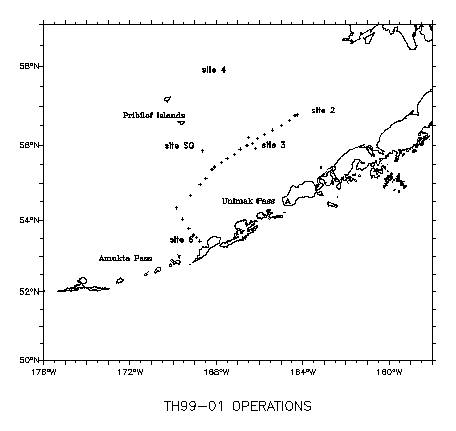|
|
|
Cruise Number: TGT99-01 FOCI Number: FOCI 1TT99
Ship:UNOLS Ship Thomas G. ThompsonArea of Operations:Bering Sea, Figure 1Itinerary:Dutch Harbor, Alaska February 5, 2000Dutch Harbor, Alaska February 12, 2000
Participating Organizations:NOAA Pacific Marine Environmental Laboratory (PMEL)NOAA Alaska Fisheries Science Center (AFSC) University of Alaska Fairbanks (UAF)
Chief Scientist:Carol DeWitt, PMELPersonnel:Reg Bigham, IOSElaina Jorgensen, AFSC Vince Kelly, Old Dominion University Sigrid Salo, PMEL Stacy Smith, UAF
Objectives of Cruise:Continue acquisition of long-term biological and physical time seriesRecover and deploy moorings at FOCI site 2 and site 3
Summary of Operations:CTD (PAR, fluorometer, transmissometer) casts: 28Bongos, 60 cm: 9 Bongos, 20 cm: 9 CalVET: 3 Mooring deployments: 5
Samples Collected:Chlorophyll samples: 84Microzooplankton samples: 3 Nutrient samples for Terry Whitledge (UAF): 96 Quantitative tow samples: 18 Zooplankton collected for stable isotope analysis (Stacy Smith - UAF):
14
Summary of Cruise:After departure from Dutch Harbor, we steamed towards site 2, in the Middle Shelf Domain. The ship proceeded slowly - due to inclement weather. As we steamed further north and east, the ship maneuvered around ice floes until it was finally impeded by compact ice - less that 10 miles from site 2. We decided to deploy two moorings at this site - one UAF sediment trap mooring, F-99BSST-2F, and one subsurface mooring, F-00BS-2A. We also completed a CTD cast and bongo tow.We then proceeded along the cross-shelf line, completing four CTD stations.
At site 3, we deployed a UAF sediment trap mooring. Triplicate CalVET tows,
a single bongo tow and a CTD cast (nutrients, chlorophylls) were completed
at the center station at site 3. A CTD cast (nutrients, chlorophylls) and
bongo tow were completed at each of the four sites surrounding site 3.
CTD casts were completed along the outer shelf line. At the shelf break,
a CTD cast (nutrients, chlorophylls) was completed at the 200m, 500m and
1000m stations; then a bongo tow was completed in the reverse order of
stations (at the 1000m, 500m and 200 m stations). We then headed north
to the St George mooring site area where we deployed F-99SG-4S and completed
a CTD cast. Then we headed south to complete the CTD casts along the "L".
At site 6, two bongo tows were completed for the University of Alaska personnel.
After completing the "L", we proceeded to Dutch Harbor.
Acknowledgements:Special thanks to the marine technicians for their support during all scientific operations - and especially to Tony Burke for making a PAR cable, enabling us to collect valuable irradiance data during CTD casts. In addition, thanks go to the engineers for their quick repair of the CTD trolley, the deck crew for their assistance during mooring operations in harsh weather conditions, the stewards department for the excellent food provided, and to the mates for their ship handling skills. Also, sincere appreciation to master Gray Drewry for an excellent job of coordinating frequently changing schedule needs, keeping lines of communications open and ensuring that our project's goals were met - as much as conditions allowed. His good spirits throughout the cruise are greatly appreciated.Tables:Table 1.0 - Master Station Log (Adobe PDF Format)Table
1.0 - Master Station Log (Microsoft Excel Format)
Figures:
|
|